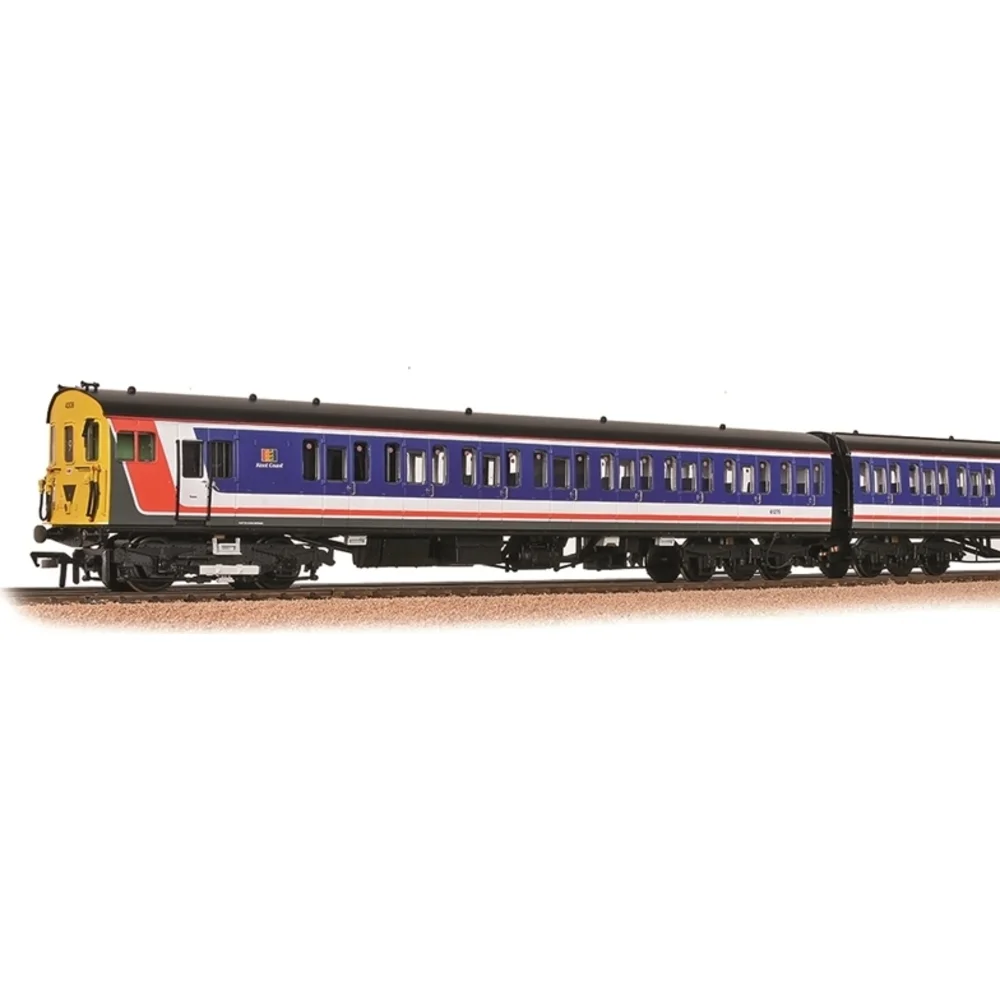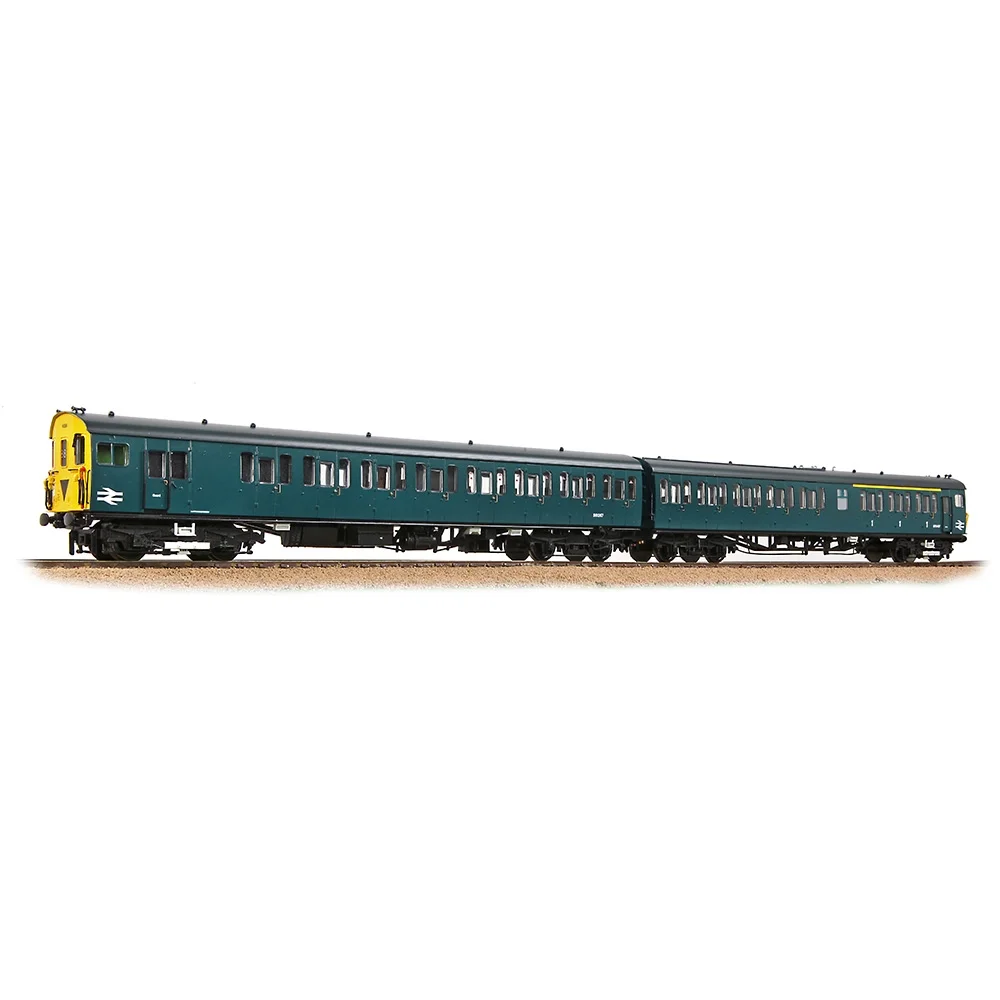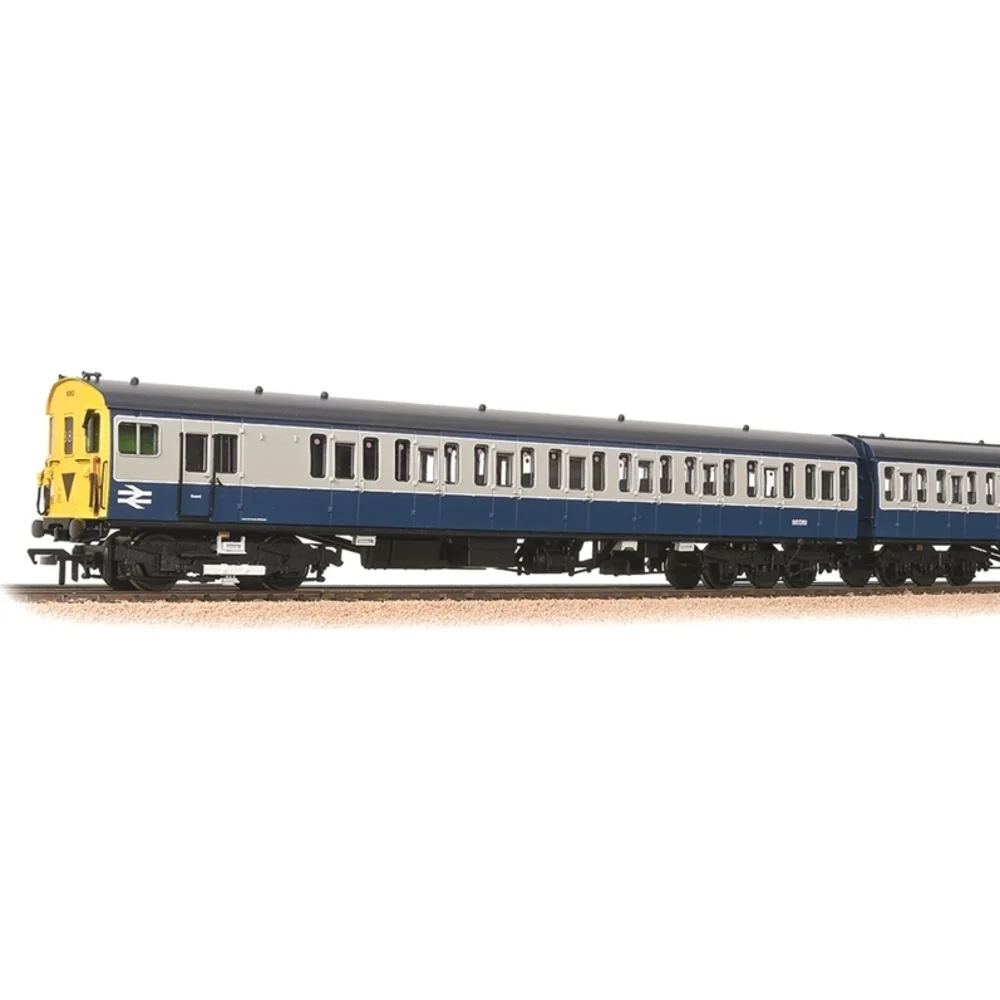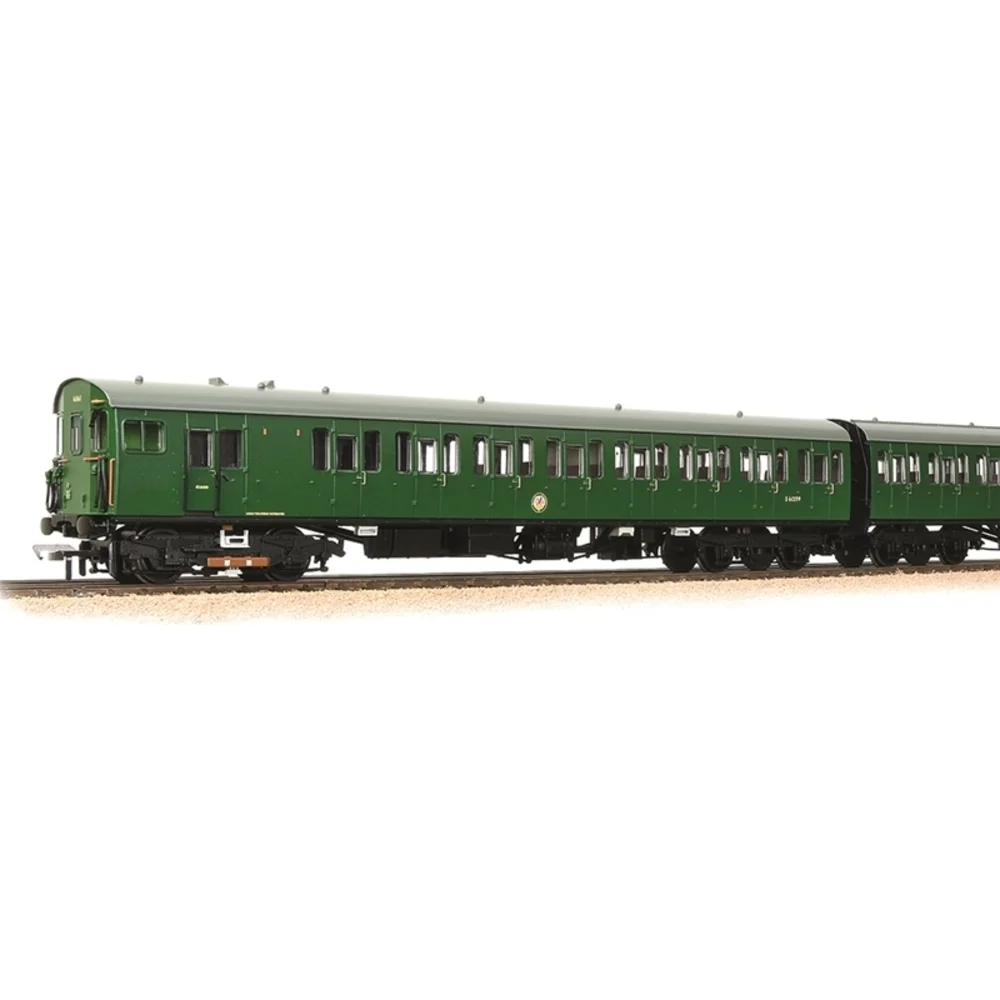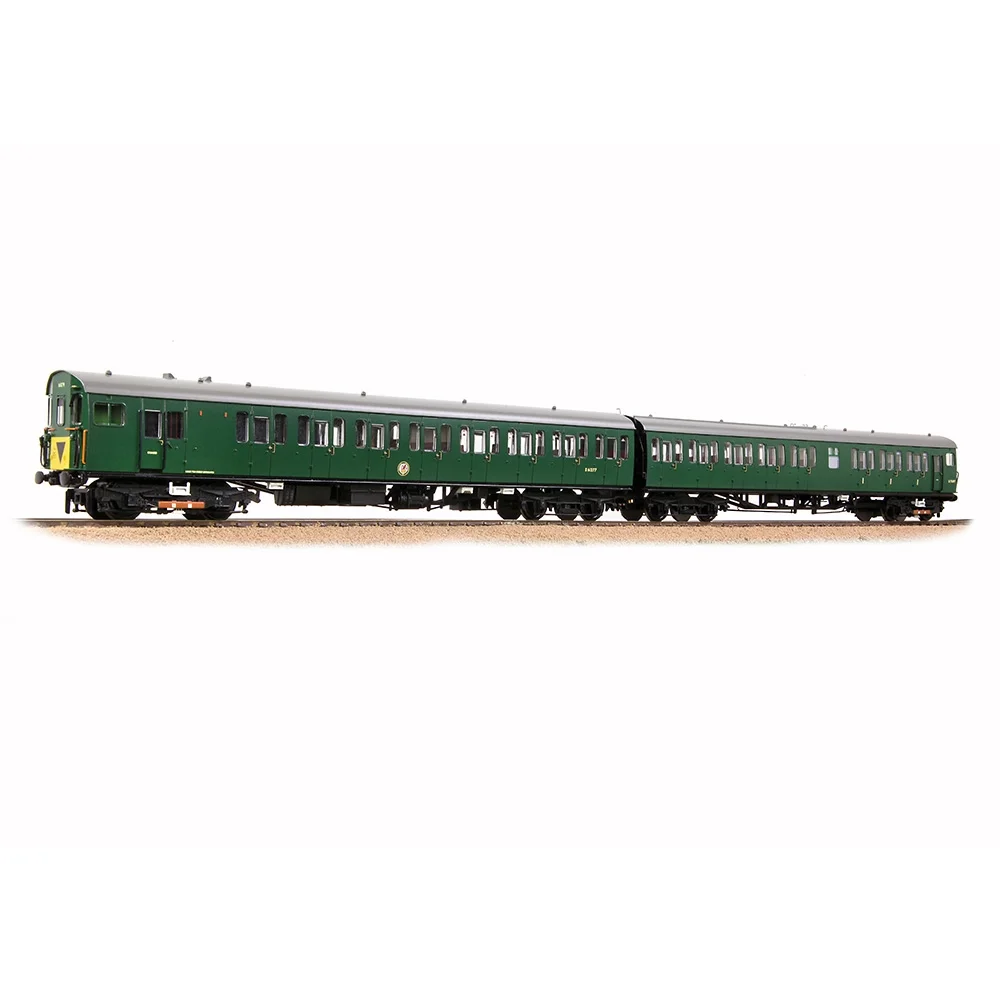British Rail Class 414 (2HAP) – Southern Region's Express Workhorse
Contents
- Historical Background and Context
- Design and Technical Specifications
- Service History and Operations
- Technical Innovation and Engineering Legacy
- Withdrawal and Preservation Legacy
- Modelling Significance and Scale Replications
- Unique Modelling Tips and Layout Integration
- Finally
- Frequently Asked Questions
- eBay Listings
The British Rail Class 414, universally known as the "2HAP" (2-car Half lavatory electro-Pneumatic), represents one of the most successful electric multiple unit designs ever to serve Britain's railways. Built between 1956 and 1963, these elegant two-car units formed the backbone of Southern Region's express fleet for nearly four decades, combining sophisticated engineering with proven reliability across some of Britain's busiest commuter routes.
With their distinctive Mark 1 coach profiles and innovative electro-pneumatic braking systems, the 209 Class 414 units revolutionised suburban and semi-fast services throughout Kent, Surrey, and Sussex. From the challenging gradients of the North Kent line to the prestigious Gatwick Airport services, these versatile units demonstrated that modern electric traction could deliver both comfort and performance whilst maintaining the operational flexibility essential for complex Southern Region timetables.
For railway enthusiasts and model railway hobbyists, the BR Class 414 offers compelling appeal: historically significant as Britain's first production electric units with electro-pneumatic braking, visually distinctive with their characteristic "slam-door" design, and blessed with remarkable longevity that saw them serving from the steam era through to Network SouthEast privatisation in 1995. Their preservation story and contemporary model railway representation ensure these iconic units remain accessible to new generations of railway enthusiasts.
Quick Takeaways
- Production total: 209 units built in four distinct batches at Eastleigh Works, representing major investment in Southern electrification
- Technical innovation: First British production EMUs with electro-pneumatic braking, enabling 90mph express operation and multiple working
- Route significance: Kent Coast electrification pioneers, operating express services from London to Dover, Margate, and Canterbury
- Service longevity: 39-year career spanning 1956-1995, from BR green through blue/grey to Network SouthEast liveries
- Operational versatility: Dual-class accommodation with first-class compartments, lavatory facilities, and express 90mph capability
- Preservation heritage: Single unit (4308/6077) preserved at Science Museum with split BR blue and Network SouthEast livery
- Modelling excellence: Available from Bachmann in multiple liveries with DCC capability and authentic period details
Historical Background and Context
The genesis of the BR Class 414 lay in the ambitious Southern Region electrification programme that transformed Britain's railway map during the 1950s and 1960s. Following nationalisation in 1948, British Railways inherited the Southern Railway's pioneering third-rail electric network, but recognised that expanding this system required modern rolling stock capable of matching contemporary performance expectations whilst accommodating the unique operational challenges of suburban and semi-fast services.
The decision to develop a standardised two-car electric multiple unit reflected both operational requirements and manufacturing economics. Unlike the pre-war Southern Railway designs with their emphasis on compartment stock and traditional construction methods, the new units would incorporate lessons learned from wartime austerity designs whilst embracing modern manufacturing techniques developed during the post-war reconstruction period. The electro-pneumatic braking system, a significant innovation for British practice, enabled the precise control essential for high-speed operation in multiple formations.
Construction commenced at Eastleigh Works in 1956, with the first units entering service in August 1957 on the challenging Sevenoaks to Cannon Street route. The timing proved fortuitous, as the initial batch displaced older 2HAL units to enable expansion of services to Gatwick Airport, demonstrating the cascading effect that new rolling stock could have on network-wide service improvements. The success of these pioneer units established the template for subsequent Southern Region EMU development.
The electrification context extended beyond simple replacement of steam services. The Kent Coast electrification scheme, one of the most ambitious railway projects of the 1950s, required rolling stock capable of working fast services over substantial distances whilst maintaining the reliability essential for commuter operations. The 2HAP units needed to handle everything from local stopping services to semi-fast expresses, often working in multiple formations that demanded sophisticated braking and control systems.
Design Innovation: Electro-Pneumatic Braking
The Class 414's electro-pneumatic braking system represented a quantum leap over traditional vacuum braking, enabling instantaneous brake application throughout multiple-unit formations. This innovation proved crucial for high-speed operation, allowing 90mph running with confidence whilst maintaining the graduated control essential for passenger comfort during station stops.
The four distinct construction phases reflected the evolving requirements of Southern electrification. The initial "1951-type" units featured electrical equipment compatible with earlier EMUs, ensuring operational flexibility during the transition period. Subsequent "1957-type" batches incorporated updated control systems and improved bogie designs, whilst the final Phase 2 units introduced Commonwealth bogies and refined detail improvements that reflected accumulated operational experience.
Design and Technical Specifications
The BR Class 414 design philosophy emphasised operational versatility within the constraints of Southern Region's third-rail infrastructure and loading gauge restrictions. Each two-car unit comprised a Driving Motor Brake Second Open (DMBSO) marshalled with either a Driving Trailer Composite with Lavatory (DTCL) or Driving Trailer Second with Kitchen (DTSK), depending on batch and subsequent modifications. This formation provided dual-class accommodation whilst maintaining the operational flexibility essential for varied service patterns.
The motor coach housed two English Electric EE507 traction motors developing a combined 1,250 horsepower, transmitted through resilient drives to the leading bogie. The express gear ratio fitted throughout the class enabled 90mph maximum speed, positioning the 2HAP units alongside the prestigious 4CEP fleet as Southern Region's premier express EMUs. The sophisticated control equipment included automatic acceleration and comprehensive safety systems that set new standards for British multiple-unit design.
Structurally, the units followed Mark 1 coach principles with stressed-skin aluminium construction welded to steel underframes. The 63ft 11½in vehicle length maximised seating capacity within platform constraints, whilst the characteristic Southern Region driving cab arrangement provided excellent forward visibility and streamlined operational procedures. The distinctive "slam-door" layout reflected passenger preferences and operational requirements that prioritised quick passenger exchange over modern accessibility standards.
The sophisticated electrical system incorporated innovations that influenced British EMU design for decades. The electro-pneumatic braking control enabled precise graduated braking throughout multiple-unit formations, whilst the comprehensive electrical interlocking systems prevented dangerous operational errors. The traction equipment featured advanced control systems that automatically managed acceleration characteristics, reducing driver workload whilst optimising energy consumption and wheel-rail adhesion.
Passenger accommodation reflected Southern Region's commitment to comfort and convenience. The first-class compartments featured individual seating with armrests and superior interior trim, whilst the second-class saloons provided the high-density seating essential for peak-hour loadings. The lavatory facilities, a significant innovation for two-car units, enabled extended diagram workings without requiring intermediate servicing stops that would disrupt intensive timetables.
Service History and Operations
The operational deployment of BR Class 414 units reflected the ambitious scope of Southern electrification and the varied service requirements across the expanding third-rail network. Initial allocation concentrated on the South Eastern Division, where the first units displaced older 2HAL stock to enable service improvements between London termini and destinations throughout Kent. The 90mph capability positioned the 2HAP fleet alongside 4CEP units as Southern Region's express EMU force.
The Kent Coast electrification programme provided the 2HAP fleet's defining operational challenge. The June 1959 commissioning of electric services to Dover and Ramsgate required rolling stock capable of sustained high-speed running over substantial distances whilst maintaining the reliability essential for intensive commuter services. The 2HAP units excelled in these demanding conditions, regularly working in formations up to twelve cars (6HAP) on peak-hour services between London and the Kent coast.
Service patterns evolved throughout the class's career, reflecting changing passenger demands and infrastructure improvements. Initial diagrams focused on semi-fast and stopping services, but operational experience demonstrated the units' versatility across the complete spectrum of Southern services. From local branch-line shuttles on the Maidstone West to Paddock Wood line to prestigious expresses between London and continental ferry ports, the 2HAP units proved their operational flexibility.
Operational Excellence: Multiple Working Capabilities
The Class 414's sophisticated electro-pneumatic control systems enabled seamless multiple working with both 2HAP units and other Southern EMU types. Formations regularly extended to 12 cars during peak hours, whilst operational flexibility allowed mixed consists with 4CEP and 4EPB units, maximising passenger capacity whilst maintaining schedule reliability.
The Gatwick Express services represented a particular operational highlight, with selected 2HAP units providing dedicated airport connections that showcased Southern Region's commitment to modern passenger services. These premium workings required exceptional reliability and punctuality, standards that the 2HAP fleet consistently achieved throughout their service lives. The airport services also demonstrated the units' suitability for specialised workings beyond conventional commuter operations.
Throughout the 1960s and 1970s, the Class 414 fleet adapted to changing operational requirements with remarkable success. The introduction of the TOPS classification system in the early 1970s redesignated the units as Class 414/2 and 414/3 (distinguishing 1951 and 1957 type electrical equipment), whilst operational modifications included downgrading first-class accommodation to create 2SAP (Second class All seating electro-Pneumatic) variants during periods of changing passenger demand.
The Network SouthEast era of the 1980s and early 1990s saw continued intensive deployment, with many units receiving comprehensive refurbishment that extended their operational lives whilst improving passenger amenities. The iconic red, white, and blue livery applied during this period created the visual identity most associated with the class's final years, whilst technical updates including simplified AWS equipment ensured continued compliance with evolving safety standards.
Fleet
No locomotives found.
Technical Innovation and Engineering Legacy
The BR Class 414 represented a crucial evolutionary step in British electric multiple unit design, introducing technical innovations that influenced EMU development for decades. The sophisticated electro-pneumatic braking system, rarely used in British practice before the 2HAP introduction, demonstrated the benefits of instantaneous brake response and graduated control that proved essential for high-speed multiple-unit operation.
The electrical control systems incorporated advanced features that set new standards for EMU design. Automatic acceleration control reduced driver workload whilst optimising traction motor performance, whilst comprehensive safety interlocks prevented potentially dangerous operational errors. The sophisticated multiple-working connections enabled seamless operation with other Southern EMU types, providing operational flexibility that proved crucial for intensive timetable operation.
Mechanical innovations included the refined bogie designs that evolved throughout the production run. Early units featured problematic bogies that required extensive modification programmes, but subsequent batches incorporated improved designs including Commonwealth bogies on Phase 2 units that delivered superior ride quality and reduced maintenance requirements. These mechanical lessons influenced subsequent Southern EMU designs throughout the diesel era.
The interior design philosophy reflected contemporary expectations of railway passenger accommodation whilst acknowledging operational realities. The compartment-saloon hybrid layout maximised seating density whilst providing passenger amenities including lavatory facilities and first-class accommodation. The characteristic "slam-door" arrangement, whilst eventually superseded by modern accessibility requirements, provided efficient passenger exchange that suited intensive timetable operation.
Withdrawal and Preservation Legacy
The withdrawal of the BR Class 414 fleet during 1994-1995 marked the end of nearly four decades of distinguished service that had established these units as among Southern Region's most successful EMU designs. The privatisation programme that created the train operating companies provided the catalyst for fleet renewal, with modern units offering improved accessibility, air conditioning, and reduced maintenance costs that made the veteran 2HAP units economically unviable despite their continued mechanical reliability.
Final operations concentrated on the South Western Division, where the units' operational flexibility and proven reliability made them valuable for covering service disruptions and peak-hour strengthening duties. The last regular passenger services operated in late 1995, though several units survived briefly for driver training and infrastructure testing duties before final withdrawal and disposal.
The preservation story reflects both the historical significance of the class and the practical challenges of preserving large electric multiple units. Unlike steam locomotives or diesel units that could operate independently, EMU preservation required appropriate electrical infrastructure and specialist maintenance facilities that limited preservation opportunities. The survival of unit 4308 (originally 6077) at the Science Museum Group collection represents a remarkable preservation achievement.
Preservation Success: Science Museum Unit
Unit 4308 provides an exceptional preservation example, featuring authentic split livery representing both BR blue and Network SouthEast eras. The motor coach (61275) and trailer (75395) offer complete technical documentation of Class 414 design, from electrical equipment through passenger accommodation, ensuring future generations can appreciate these pioneering EMUs.
The scrapping programme that eliminated the majority of the fleet reflected both the practical challenges of EMU disposal and the limited heritage awareness that characterised 1990s railway privatisation. Many units provided components for other Southern EMU refurbishment programmes, whilst the specialist materials and electrical equipment required careful disposal procedures that added complexity and cost to the scrapping process.
The engineering legacy extends far beyond the units themselves. The technical innovations pioneered on the Class 414 - including electro-pneumatic braking, sophisticated control systems, and multiple-working capabilities - influenced British EMU design through to the present day. Modern units like the Class 375 "Electrostar" directly trace their ancestry to innovations first proven on the 2HAP fleet.
Modelling Significance and Scale Replications
The BR Class 414 occupies exceptional significance in the model railway world, representing both the technical sophistication of post-war British engineering and the visual appeal of Southern Region's distinctive EMU designs. For modellers recreating the golden age of Southern electric operation, these units provide authentic prototype representation across multiple decades and service types, from rural branch lines to prestigious express workings.
Bachmann leads contemporary 2HAP modelling with their comprehensive range covering all major livery variations and operational periods. The models feature unprecedented accuracy in both external appearance and technical detail, incorporating the authentic "slam-door" layout, period-specific headcode displays, and era-appropriate equipment variations that distinguish different production batches. The DCC-ready design accommodates modern digital control systems whilst maintaining scale authenticity.
The modelling appeal extends beyond simple locomotive representation to encompass broader themes of Southern electrification and post-war railway modernisation. Layout builders can recreate the transformation from steam to electric operation, illustrate the operational complexity of multiple-unit working, and demonstrate the sophisticated service patterns that characterised Southern Region's intensive timetables.
Models
| Builder | Catalogue # | Year | Running # | Class, Operator (Livery) "Name" | Scale | Finish | Era | DCC |
|---|---|---|---|---|---|---|---|---|
| Bachmann | 31-390 | 2016 | 6061 | British Rail Class 414, British Railways (Green with Late Crest) | OO | P | 5 | DCC21 |
| Bachmann | 31-391 | 2016 | 6062 | British Rail Class 414, British Rail (Blue & Grey) | OO | P | 7 | DCC21 |
| Bachmann | 31-392 | 2016 | 4322 | British Rail Class 414, British Rail Network SouthEast (Red, White & Blue) | OO | P | 8 | DCC21 |
| Bachmann | 31-393 | 2025 | 6079 | British Rail Class 414, British Railways (Southern Region Green) | OO | P | 5 | DCC21 |
| Bachmann | 31-393SF | 2025 | 6079 | British Rail Class 414, British Railways (Southern Region Green) | OO | P | 5 | DCCS |
| Bachmann | 31-394 | 2025 | 6089 | British Rail Class 414, British Rail (Blue) | OO | P | 7 | DCC21 |
| Bachmann | 31-394SF | 2025 | 6089 | British Rail Class 414, British Rail (Blue) | OO | P | 7 | DCCS |
Sound-equipped versions offer exceptional opportunities for authentic operational recreation. The characteristic traction motor noise, brake applications, and passenger announcements create immersive experiences that transport operators and viewers to the heyday of Southern electric operation. The sophisticated electrical systems that distinguished the prototype translate effectively to model operation through DCC systems that replicate multiple-working capabilities and graduated braking characteristics.
Advanced modellers appreciate the technical accuracy that contemporary manufacturers achieve. Period-specific details including different bogies (Mark 1, Mark 3B, Mark 4, Commonwealth), roof equipment variations, and batch-specific modifications enable construction of authentic models representing specific prototype units at particular periods. This attention to detail satisfies serious railway modellers whilst providing educational value for those interested in railway development.
Unique Modelling Tips and Layout Integration
Successfully incorporating BR Class 414 models into layout operation requires understanding the sophisticated service patterns that characterised Southern electric operations. Unlike simple point-to-point workings, 2HAP units typically worked complex diagrams involving multiple formations, route variations, and service types that provided operational interest whilst remaining prototypically accurate.
Authentic operational scenarios should emphasise the multiple-working capabilities that distinguished Southern EMU operation. Formations regularly varied between 2, 4, 6, 8, or even 12 cars depending on service requirements and passenger loadings. Model layouts benefit from incorporating the sophisticated signalling and electrical systems that enabled these complex operations, including multiple-aspect colour-light signals and third-rail electrical infrastructure.
Station design requires careful attention to Southern Region practice and the specific requirements of EMU operation. Platforms need appropriate lengths for multiple-unit formations, whilst infrastructure should include the electrical supply arrangements, EMU maintenance facilities, and passenger amenities that characterised Southern electric operation. The distinctive architecture of stations like Canterbury East, Dover Priory, and Ramsgate provides authentic prototype inspiration.
Advanced Operation: Multiple Formation Working
Authentic Class 414 operation involves complex formation changes throughout service diagrams. A typical working might commence with 2HAP operation during off-peak hours, strengthen to 4HAP for commuter services, then reduce again for quieter periods. Modern DCC systems can replicate these operational patterns through sophisticated consisting and programming.
Timetable construction should reflect the intensive nature of Southern electric operation and the operational flexibility that EMUs provided. Services operated at frequent intervals with complex interconnections between routes, whilst the rapid acceleration and braking capabilities enabled tight scheduling that would challenge conventional locomotive-hauled operation. Peak-hour intensification provides particularly authentic operational scenarios.
Weathering approaches require careful consideration of Southern EMU maintenance standards and operational environments. These units operated from purpose-built electric depots with comprehensive washing facilities, resulting in generally clean external appearance that contrasts with the grimy conditions often associated with steam or diesel traction. Subtle weathering reflecting electrical equipment exposure and passenger loading provides authentic visual effects without overdoing industrial grime.
Lighting effects offer exceptional opportunities for authentic night-time operation. The extensive interior lighting that characterised passenger EMUs creates attractive visual effects during layout operation, whilst the sophisticated headcode and marker light arrangements provide authentic visual signals about service types and destinations. Modern LED technology enables realistic reproduction of these prototype features.
Sound programming should emphasise the characteristic electrical equipment noise that distinguished EMU operation. The motor-generator sets, compressor systems, and electrical contactors create distinctive soundscapes that immediately identify electric traction. Combined with appropriate station announcements and safety warnings, these audio elements create immersive operational experiences.
Finally
The British Rail Class 414 stands as testament to the vision and engineering excellence that transformed Britain's railways during the post-war modernisation era. These elegant two-car units proved that electric multiple unit design could successfully combine operational sophistication with passenger comfort, creating machines capable of handling everything from rural branch services to prestigious express workings with equal competence and reliability.
The technical innovations pioneered on the 2HAP fleet - from electro-pneumatic braking through sophisticated multiple-working systems to advanced electrical control equipment - established design principles that continue influencing EMU development today. Modern electric multiple units directly trace their ancestry to concepts first proven successful on these pioneering Southern Region units, demonstrating how thoughtful engineering responding to real operational needs can create designs of enduring value.
For contemporary railway enthusiasts, the Class 414 represents multiple opportunities for appreciation and understanding. The preserved unit at the Science Museum provides tangible connection to this crucial period in railway development, whilst excellent model railway representations enable authentic recreation of Southern electric operations across multiple scales and operating environments.
The cultural significance extends beyond purely technical achievement to encompass the broader transformation of British transport during the 1950s and 1960s. These units carried millions of passengers during the economic growth and social change that characterised post-war Britain, providing reliable transport that enabled the suburban expansion and economic development that shaped modern society. Their distinctive appearance and operational characteristics became integral parts of the Southern counties landscape.
Perhaps most importantly, the BR Class 414 story illustrates how successful engineering emerges from understanding operational requirements and passenger needs rather than pursuing technology for its own sake. The 39-year service life achieved by these units demonstrates that designs optimised for real-world conditions can provide exceptional longevity and value, offering lessons that remain relevant for contemporary transport planning and engineering.
As preserved examples and authentic model reproductions continue introducing new generations to these remarkable machines, the Class 414 legacy ensures that future railway enthusiasts can appreciate both the technical achievement and the operational excellence that these pioneering electric multiple units represented during their distinguished careers.
Frequently Asked Questions
What does "2HAP" stand for and why was this designation used?
2HAP denotes "2-car Half-A-lavatory electro-Pneumatic," indicating a two-car formation with lavatory facilities in one vehicle and innovative electro-pneumatic braking. This Southern Railway coding system continued through BR era until TOPS classification introduced Class 414 numbering in the early 1970s.
How many Class 414 units were built and what were the main production batches?
A total of 209 units were constructed at Eastleigh Works between 1956-1963 in four distinct batches. First batch (1957): units 6001-6042, second batch (1958): 6043-6105, third batch (1961): 6106-6146, and fourth batch (1963): 6147-6173, each featuring progressive technical improvements.
What made the electro-pneumatic braking system so significant for British railways?
Electro-pneumatic braking enabled instantaneous brake application throughout multiple-unit formations, crucial for 90mph operation and complex multiple working. Unlike traditional vacuum braking with sequential response delays, EP braking provided precise graduated control essential for intensive timetable operation and passenger comfort.
Which routes and services were Class 414 units primarily used on?
Initially deployed on Kent Coast electrification services including London to Dover, Ramsgate, Canterbury and Margate routes. Later operations extended to South Western Division including Gatwick Airport services, Portsmouth line workings, and various suburban routes throughout Southern Region network.
What was the seating arrangement and passenger accommodation like?
Standard formation provided 153 seats: 19 first-class in compartments with individual seating and armrests, plus 134 second-class in open saloons. One vehicle featured lavatory facilities whilst slam-door construction enabled rapid passenger exchange during intensive station stops.
Why were some units converted to "2SAP" configuration during the 1970s?
Economic pressures led to first-class downgrading in 51 units (1974-1980), creating 2SAP (Second class All seating electro-Pneumatic) variants with 160 all-second seats. This temporary measure provided additional suburban capacity during service reorganisation, but original configurations were later restored.
Are any Class 414 units preserved and where can they be seen?
Unit 4308 (original 6077) comprising motor coach 61275 and trailer 75395 is preserved at Science Museum Group collection. This unique survivor features split livery showing BR blue on one side and Network SouthEast colours on the other, illustrating the unit's long service evolution.
What model railway options exist for Class 414 representation?
Bachmann produces excellent OO gauge models in multiple liveries (31-390 BR green, 31-391 blue/grey, 31-392 Network SouthEast) featuring DCC compatibility, interior lighting, and authentic period details. N gauge paper models also available from specialist manufacturers for smaller scale layouts.
How did Class 414 units work in multiple formations with other EMU types?
Sophisticated electrical control systems enabled seamless multiple working with 4CEP, 4EPB, and other Southern EMUs. Formations regularly extended to 12 cars during peak hours using Buck-eye couplers with comprehensive electrical connections for coordinated traction and braking throughout the consist.
What technical problems affected Class 414 units during early service?
Initial bogie designs suffered reliability problems similar to Hastings diesel units, requiring extensive modification programmes from 1958. Later batches incorporated improved Mark 3B and Commonwealth bogies that delivered superior ride quality and reduced maintenance requirements throughout subsequent service.
When and why were Class 414 units finally withdrawn from service?
Withdrawal occurred 1994-1995 during railway privatisation as modern units offered improved accessibility, air conditioning, and reduced maintenance costs. Final operations concentrated on South Western Division with last regular passenger services ending late 1995, concluding 39 years of distinguished service.
How should model Class 414 units be weathered for authentic appearance?
Subtle weathering reflecting electrical depot maintenance standards: light soiling around electrical equipment, passenger door areas, and bogies, but avoiding heavy industrial grime. Different eras require varied approaches - 1960s units cleaner than 1990s examples reflecting changing maintenance standards.
